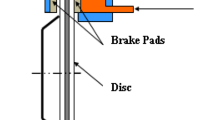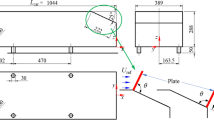Abstract
Hydraulic retarders are auxiliary braking devices that reduce the velocity of a vehicle, particularly when a vehicle is driven downhill. Such velocity reduction could reduce the potential risk caused by brake failure caused by the service brake working for a long time and the temperature of the brake shoe becomes extremely high. This paper introduces the construction of the hydraulic retarder and proposes two mathematical models for the hydraulic retarder. The first mathematical model is deduced by using fluid mechanics, which is used to analyze the mechanism of how braking torque is produced and the key factors that can influence the value of the braking torque. The second mathematical model is deduced by using thermodynamics, which is used to quantify the heat produced by the hydraulic retarder. This research emphasizes that the flow rate and the average velocity of the working fluid in the working chamber mainly determine the braking torque of the hydraulic retarder. The flow rate into and out of the working chamber determines the temperature rise of the working fluid. Computational fluid dynamics (CFD) simulations are conducted with the Reynolds-averaged Navier-Stokes (RANS) and Shear Stress Transport (SST) turbulent models. Experiments are carried out to justify the two mathematical models and the CFD simulations. The results show that the mathematical models are capable of describing the force analysis and energy conversion of the hydraulic retarder and SST is more accurate for CFD simulation and the error is within 6 %.
Similar content being viewed by others
Abbreviations
- CV :
-
control volume, m3
- CS :
-
control surface, m2
- P :
-
braking power, kW
- M :
-
braking torque, Nm
- n :
-
rotational speed of the rotor, rpm
- Q :
-
internal energy, kJ
- κ :
-
coefficient of the unit
- c :
-
specific heat, kJ/(kg·°C)
- ΔT :
-
temperature rise, °C
- \(\overrightarrow{v}\) :
-
fluid velocity, m/s
- \(\overrightarrow{v}\) r :
-
fluid velocity relative to the control surface, m/s
- l :
-
direction normal to the surface
- ṁ 1 :
-
flow rate into and out of the rotor, kg/s
- ṁ 2 :
-
flow rate into and out of the working chamber, kg/s
- v':
-
velocity of the fluid into and out of the working chamber, m/s
- v avg1 :
-
average velocity of the working fluid into and out of the rotor, m/s
- v avg2 :
-
average velocity of the working fluid into and out of the working chamber, m/s
- ρ :
-
density of the working fluid, kg/m3
- A CS1 :
-
area where the working fluid flows into the rotor, m2
- A CS2 :
-
area where the working fluid flows out of the rotor, m2
- r 1 :
-
external diameter, mm
- r 2 :
-
inner diameter, mm
- r 3 :
-
torque diameter, mm
- F 1 :
-
resultant force, N
- F 2 :
-
component force along the axial, N
- F 3 :
-
component force normal to r3, N
- F it :
-
force caused by the working fluid into and out of the rotor, N
- F io :
-
force caused by the working fluid into and out of the working chamber, N
- θ :
-
angle between the interface and the streamline, o
- f 1, f 2, f 3 :
-
function of diameter of circulation circle
References
American National Standard (1994). Engine Retarder Dynamometer Test and Capability Rating Procedure. SAE Technical Standard.
Gomes, R. A. and Niehuis, R. (2013). Film cooling on highly loaded blades with main flow separation-Part I: Heat transfer. J. Turbomachinery 135, 1, 011044-1-011044-9.
Hammad, K. J. (2015). The flow behavior of a biofluid in a separated and reattached flow region. J. Fluids Engineering 137, 6, 061104-1-061104-8.
Liu, C. Y., Jiang, K. J. and Zhang, Y. (2011). Design and use of an eddy current retarder in an automobile. Int. J. Automotive Technology 12, 4, 611–616.
Le Gigan, G., Vernersson, T., Lunden, R. and Skoglund, P. (2015). Disc brakes for heavy vehicles: An experimental study of temperatures and cracks. Proc. Institution of Mechanical Engineers, Part D: J. Automobile Engineering 229, 6, 684–707.
Li, J., Cai, Z. and Jia, Z. (2014). Simulation of constant speed control on coach hydraulic retarder on special weather condition. J. System Simulation 26, 11, 2765–2769.
Liu, X., Zhao, Y., Shan, Y. and He, T. (2014). Nonlinear dynamics modeling and analysis of disc brake squeal considering acting process of brake force. J. Vibroengineering 16, 4, 1964–1976.
Mew, T. D., Kang, K. J., Kienhofer, F. W. and Kim, T. (2015). Transient thermal response of a highly porous ventilated brake disc. Proc. Institution of Mechanical Engineers, Part D: J. Automobile Engineering 229, 6, 674–683.
Park, J. H., Park, T. W., Lee, J. H. and Cho, M. H. (2014). Hot judder simulation of a ventilated disc and design of an improved disc using sensitivity analysis. Int. J. Automotive Technology 15, 1, 1–6.
Wei, W., Li, H. Y., Zou, B. and Yan, Q. D. (2010). Study on braking performance and analysis of two-phase flow in vehicular hydraulic retarder. Trans. Beijing Institute of Technology 30, 11, 1282–1284.
Yunus, A. C. and Cimbala, J. M. (2006). Fluid Mechanics: Fundamentals and Applications. Int. edn. McGraw-Hill. New York, USA.
Yan, J., Guo, X. and Wu, B. (2010). Modeling and simulation on hydraulic retarder oil charging and discharging control system. SAE Paper No. 2010-01-0269.
Author information
Authors and Affiliations
Corresponding author
Rights and permissions
About this article
Cite this article
Zheng, H., Lei, Y. & Song, P. Hydraulic retarders for heavy vehicles: Analysis of fluid mechanics and computational fluid dynamics on braking torque and temperature rise. Int.J Automot. Technol. 18, 387–396 (2017). https://doi.org/10.1007/s12239-017-0039-z
Received:
Revised:
Accepted:
Published:
Issue Date:
DOI: https://doi.org/10.1007/s12239-017-0039-z




